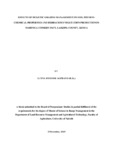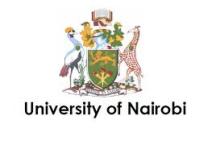Resource information
This study evaluated the effects of holistic grazing management (HGM) on biomass production and soil properties under holistic and non-holistic grazing sites. The study was conducted in two Group Ranches namely, Koija and Il Motiok in Naibunga Conservancy, Laikipia County, Kenya. Vegetation attributes and soil parameters were determined in four plots randomly sited and established within the Il Motiok Ranch, which is under HGM, and in the same number of plots sited and established in Koija Ranch which is under free-range grazing system. Herbaceous vegetation and soil parameters were determined along two transects placed diagonally across each plot. Along each transect, soil samples were collected at two depths 0-10cm and 10-20cm using a standard soil auger. The results of the analyses show that herbaceous standing biomass and yield was higher (P ≤ 0.05) in holistic than non-holistic grazing sites. Mean organic carbon and moisture content, pH, total nitrogen, cation exchange capacity (CEC), potassium, phosphorus, aggregate stability, hydraulic conductivity, and water content were significantly higher (P < 0.005) under holistic grazing than non-holistic grazing sites. Conversely, soil bulk density and penetration resistance were greater under holistic grazing regimes. This study has demonstrated that holistic grazing management has the potential to significantly improve the soil properties and range productivity. These results are attributed to the beneficial effects of grazing that includes hoof action on soil and fertilization from animal dung and manure that occur when grazing animals are congregated together to assert maximum impact on soil and pasture for a short duration followed by adequate rest durations to allow post-grazing pasture recovery. However, monitoring of the study sites would be helpful in determining the long-term effects of holistic grazing management in pastoral rangelands.
KEY WORDS: Vegetation attributes, Organic matter, Livestock grazing, Semi-arid lands


